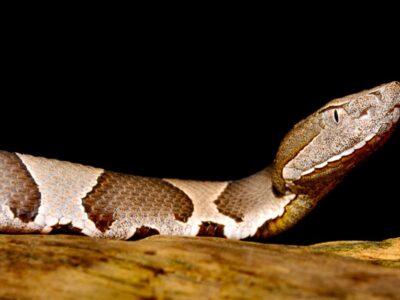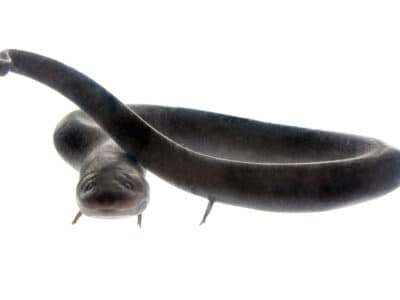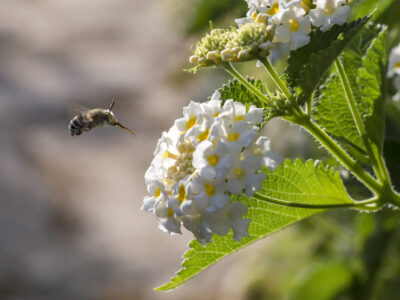Missouri is categorized as a southern and midwestern state and its geography and climate — humid continental in the north and humid subtropical in the rest of the state — allow it to have an abundance of wildlife. Wild animals benefit from Missouri’s many bodies of water, public forests, and wilderness areas, including the famous Mark Twain National Forest. Read on for more information about Missouri’s wildlife.
The Official Animal of Missouri
Missouri doesn’t have an official overall animal, but its official mammal since 1995 is the Missouri mule. This doughty creature has been invaluable to farmers since the 1820s and was used in the two World Wars to move the troops and their supplies. For many years, Missouri was the source for the best mules. Missouri was considered the source for the best mules and it has been its state mammal since 1995.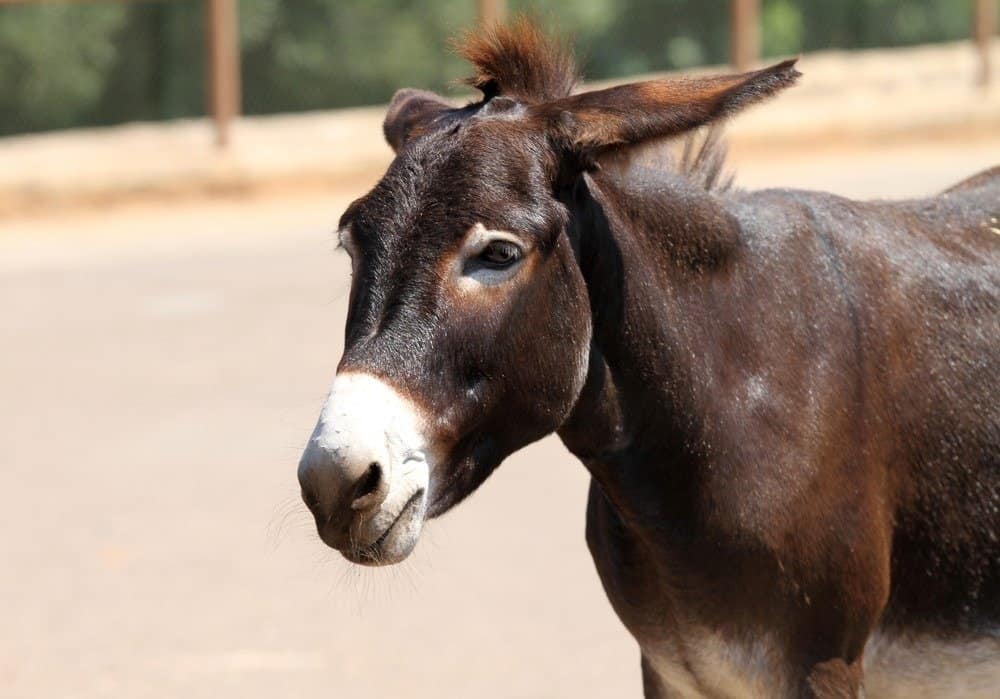
©BlackDorianstock/Shutterstock.com
Official state bird: Eastern bluebird
This little ambush predator thrush with the cheerful song is the official bird of Missouri and several other states.
Official state fish: Channel catfish
This is a popular and abundant catfish and makes for good eating. It adapts so well to bodies of water that it’s considered invasive in some countries where it’s been introduced.
Official state insect: Western honeybee
The honeybee, which lives in colonies that revolve around a queen, is an indispensable pollinator.
Official state amphibian: American bullfrog
This large and rather aggressive frog gets its name because its call sounds like the bellowing of a bull.
Where to Find the Top Wild Animals in Missouri
Places to find the top wild creatures in Missouri include the 3,068,800 acre Mark Twain National Forest, found in the southern part of the state in the ancient Missouri Ozarks. Here there are more than 650 native wildlife species, including nearly 200 types of fish, about 100 amphibians and reptiles, more than 300 breeds of birds, and around 60 species of mammal. Some wilderness areas in the park are the Devils Backbone, Bell Mountain, Paddy Creek and Piney Creek. In these areas, visitors can fish and catch glimpses of skunks, white-tailed deer, foxes, and coyotes.
Other state parks are Lake of the Ozarks State Park, Roaring River State Park, and Johnson’s Shut-Ins State Park. Visitors can hunt, fish, and birdwatch in Ozark National Scenic Riverways.
Visitors to Two Rivers National Wildlife Refuge in Brussels can spot more than 200 bird species, including waterfowl in the spring and bald eagles in the winter, as well as turkeys, beavers, muskrats, and deer.
Elk, bison, Texas longhorn cattle, and whitetail deer roam the lands of Dogwood Canyon Nature Park, which covers more than 10,000 acres in Lampe. Mark Twain National Forest houses more than 650 wildlife species native to Missouri. ©Randy Kostichka/Shutterstock.com
Wild Animals in Missouri
Mammals
Mammals in Missouri range from herbivores to predators, to the tiny least shrew to the American bison.
Rodents found in Missouri include several species of mice and rats, including the golden mouse and the fulvous harvest mouse. Other rodents are voles and woodrats, the southern bog lemming, the eastern gray squirrel, flying squirrels, the eastern chipmunk, the groundhog and the pocket gopher. Larger rodents are the beaver and the nutria, which isn’t native to Missouri and is now considered invasive in many places.
Though shrews resemble mice, they are not rodents but belong to the Soricidae family. Ones that live in Missouri are the northern and southern short-tailed shrew, Elliot’s short-tailed shrew and the common shrew. Their somewhat distant relative, the eastern mole, can also be found in Missouri.
The American bison was reintroduced into Missouri after being nearly hunted to extinction. This huge herbivore can now be found in Prairie State Park in Barton County. Other large mammals are white-tailed deer and elk, including the Rocky Mountain elk, which was introduced into the state. Mule deer are can be found in Missouri but are considered vagrants. Wild boar are also not native to the state but are favorite game animals.
Since wolves were extirpated from Missouri, the top canine predator is now the coyote, followed by the gray and the red foxes. Another of the predators is the bobcat. The cougar has been known to wander in and out of the state, even though it’s considered extirpated. The black bear is the largest of the mammalian predators in Missouri, even though it mostly eats plant material.
Other mammals are the opossum, the American mink, types of weasels, the North American river otter and the striped and eastern spotted skunk. Missouri is also home to the badger, a medium-sized, fossorial cousin of the weasel. There are many species of bat, including the Mexican free-tailed bat, which is one of the most common chiropterans. Rabbits are found in Missouri, and the nine-banded armadillo has also made its way into the state. The top canine predator in Missouri is the coyote. ©Paul Tessier/Shutterstock.com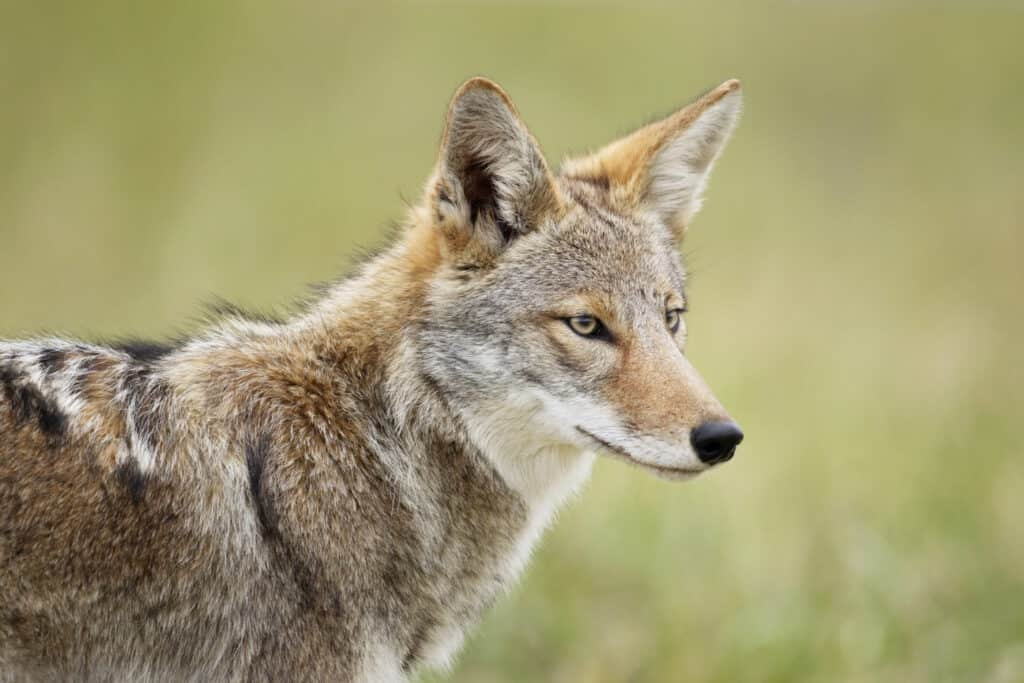
Birds
With its freshwater lakes, ponds, streams, and rivers, Missouri is a haven for birds. Among them are swans, ducks, geese, and wading birds such as herons and egrets. Gulls and the American and brown pelican are also found in Missouri, as are cormorants and the roseate spoonbill with its lovely flamingo-pink feathers. The common loon has a strange, haunting call and can barely walk on land because its legs are too far back on its body. Even birds normally found at sea such as the northern storm petrel and frigatebirds visit landlocked Missouri.
Besides the eastern bluebird, songbirds found in Missouri include vireos, wood peewees, flycatchers, kingbirds, bluejays, crows, chickadees, larks, swallows, nuthatches, wrens, thrashers, and mockingbirds. Finches, buntings, and sparrows make their home in Missouri, as do warblers and tanagers. The ovenbird, which breeds in Missouri and winters in Central America and the Caribbean, gets its name for the shape of its nest.
Woodpeckers are numerous in Missouri, and their number may include the rarest woodpecker, the ivory-billed. Indeed, this woodpecker may already be extinct. The roseate spoonbill, which has beautiful rose-colored wings, can be found in Missouri. ©iStock.com/Canon_Bob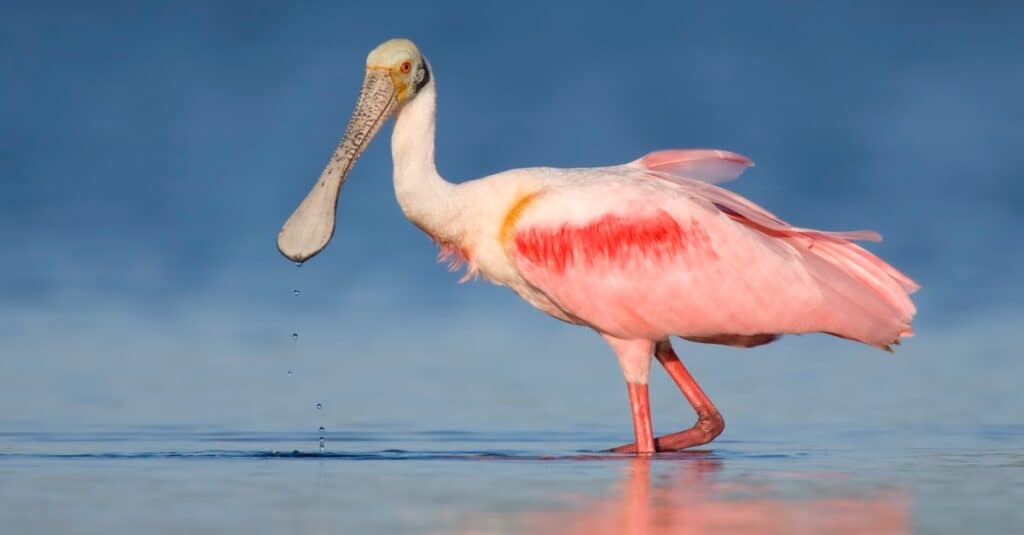
Reptiles and Amphibians
The climate of the southern part of the state and the prevalence of bodies of water make Missouri a good place for reptiles and amphibians. Reptiles include the Texas horned lizard and several species of skink, the glass lizard and many species of snakes and turtles, including the huge alligator snapping turtle. Most snakes in Missouri are non-venomous, but people should be wary of the venomous cottonmouth, copperhead, and at least three species of rattlesnake. Read here to learn about the venomous snakes in Missouri.
Amphibians include the common mudpuppy and other species of salamander such as the grotto salamander and the central newt. Frogs and toads besides the bullfrog include the common toad, the eastern narrow-mouthed toad, the striped chorus frog and the crawfish frog, named because it lives in crawfish burrows most of the time. The alligator snapping turtle is one of the reptile species that makes Missouri its home. ©iStock.com/Sista Vongjintanaruks
Insects
Insects are the most common animals found in Missouri. These creatures are usually winged and have six legs, and much of how they are classified is based on their mouthparts. Among the great variety of insects of Missouri are ants, bees, wasps, butterflies, roaches, dragonflies, damselflies, grasshoppers, beetles, and true bugs. Among the true bugs is a strange creature called the masked hunter, a type of assassin bug whose nymph tries to camouflage itself under layers of dust and dirt. It eats bedbugs but can deliver a nasty bite to a human, so it’s not really a solution to a bedbug infestation.
Blister beetles release a chemical that can, as its name says, raise blisters on skin. The blue death-feigning beetle can roll over and play dead for hours and can be kept as a pet. The American ermine moth has wings like the ermine on a monarch’s robes, pure white with black spots. The glue-eating silverfish is also considered an insect even though it lacks wings. The broad-headed sharpshooter is a leafhopper that gets its name because it fires a stream of liquid offal at would-be predators to dissuade them. Blister beetles, which secrete a caustic substance that can cause painful blisters, are present in Missouri. ©Suede Chen/Shutterstock.com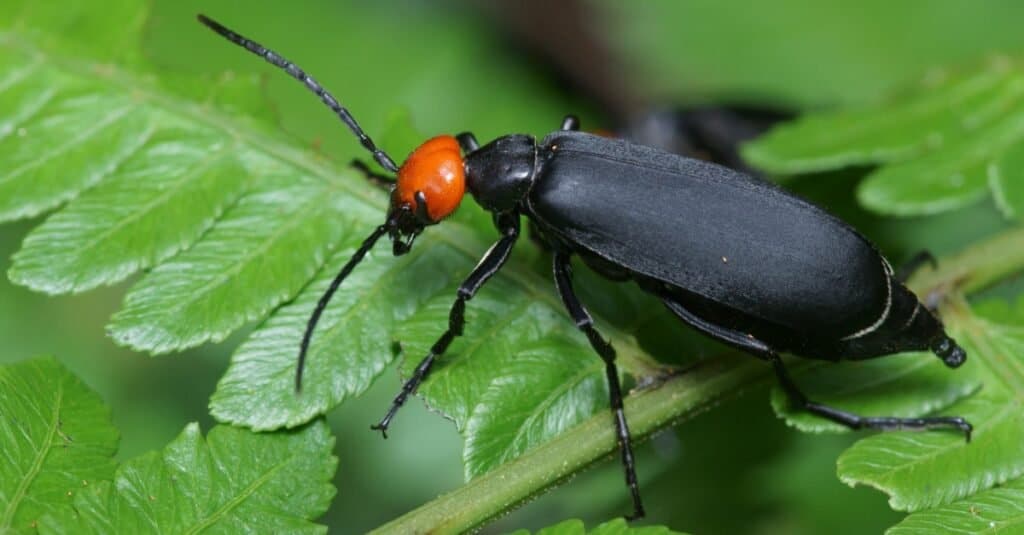
Other Arthropods
Spiders found in Missouri are American house spiders, crab spiders, orb web weavers, wolf spiders, and jumping spiders. The brown recluse and black widow are also found in the state, and though they are pretty docile their venom is powerful. The Missouri tarantula is the state’s only tarantula, but it is peaceful and its venom isn’t life-threatening. The Daddy long legs is not really a spider, for it has neither fangs nor venom.
Other arthropods found in Missouri are centipedes, ticks, millipedes, crayfish, isopods, and amphipods. Missouri has a range of spider species in the state, including wolf spiders. ©iStock.com/Henrik_L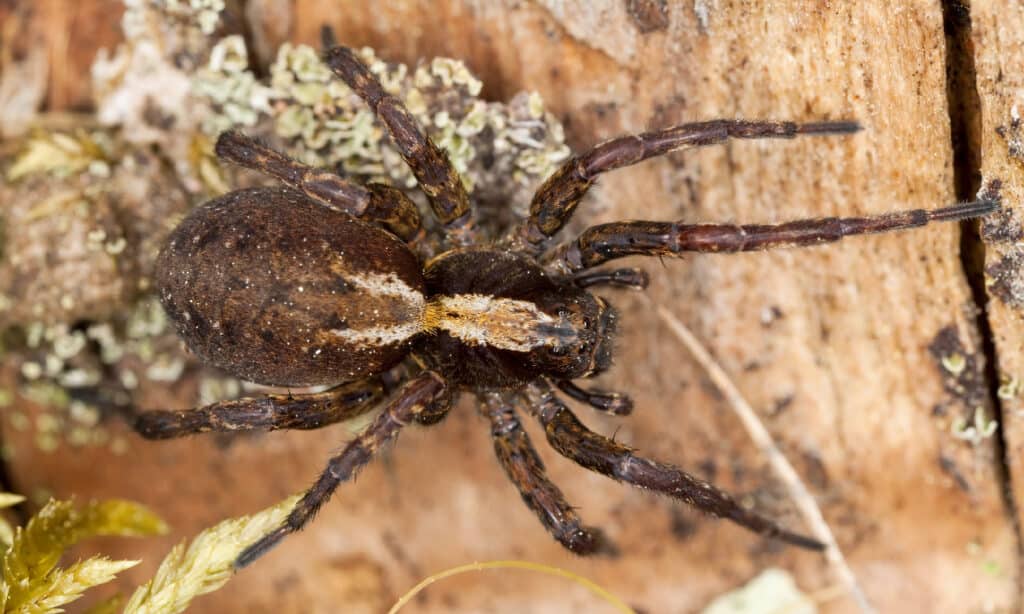
Fish
Missouri is a paradise for fish as well as the people who want to catch them. One of those fish is the lake sturgeon, which is endangered in Missouri due to overfishing. It’s found at the bottom of lakes or wide rivers. The bowfin, which is native to Missouri, is often mistaken for the snakehead, and both fish can breathe air. Other fish are suckers, quillbacks, and buffalos, which are given their name because they have a hump. Other Missouri fish are redhorses, sunfish, darters, bluegill, walleye, sauger, crappie, and different species of bass. Species of carp were introduced or escaped from fish farms and are now invasive.
The northern pike is a fish that usually grows to around 22 inches long but can grow nearly 5 feet in length. It’s an aggressive and territorial fish that will cannibalize its own species if there’s no other food around. It usually eats other, smaller fish, but larger ones will eat meadow jumping mice that wind up in the water.
Missouri has chubs and minnows, pikes, pickerel, muskellunge and different species of catfish, including bullheads and madtoms. There are also gars, including the alligator gar and the longnose gar. Rainbow trout can be found beneath dams, as well as with the brown trout in lakes, rivers, and streams. Often found in cave pools, crayfish are necessary to the health of Missouri’s bodies of water. It’s possible for Missouri’s aggressive and territorial northern pike to grow to nearly 5 feet in length.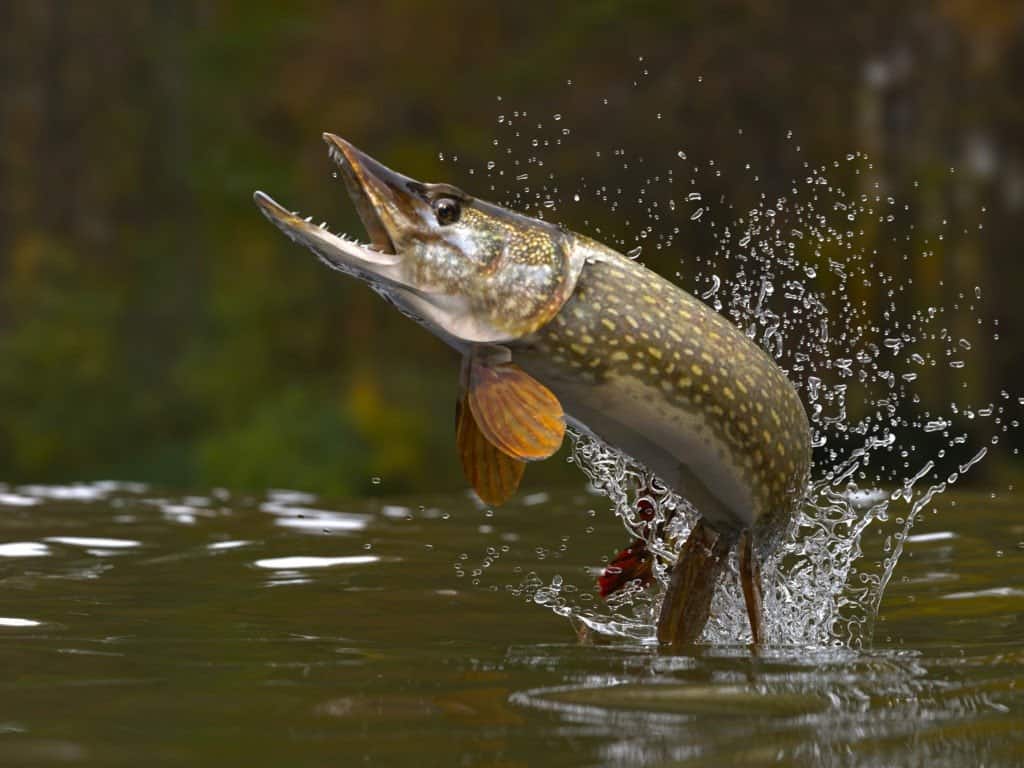
©bekirevren/Shutterstock.com
Freshwater Mollusks
Missouri has many species of freshwater mollusks, especially freshwater mussels. They include the elktoe and the snuffbox, which are both endangered, the spectaclecase, the white heelsplitter and the paper pondshell (which can be both male and female at the same time). Other mussels are the monkeyface, the wartyback, and the pimpleback.
The Asiatic clam, which comes from eastern Asia, has also found its way into the Missouri waters, most likely through the release of ballast water from boats that had gone out to sea. The snuffbox is an endangered freshwater mussel found in Missouri.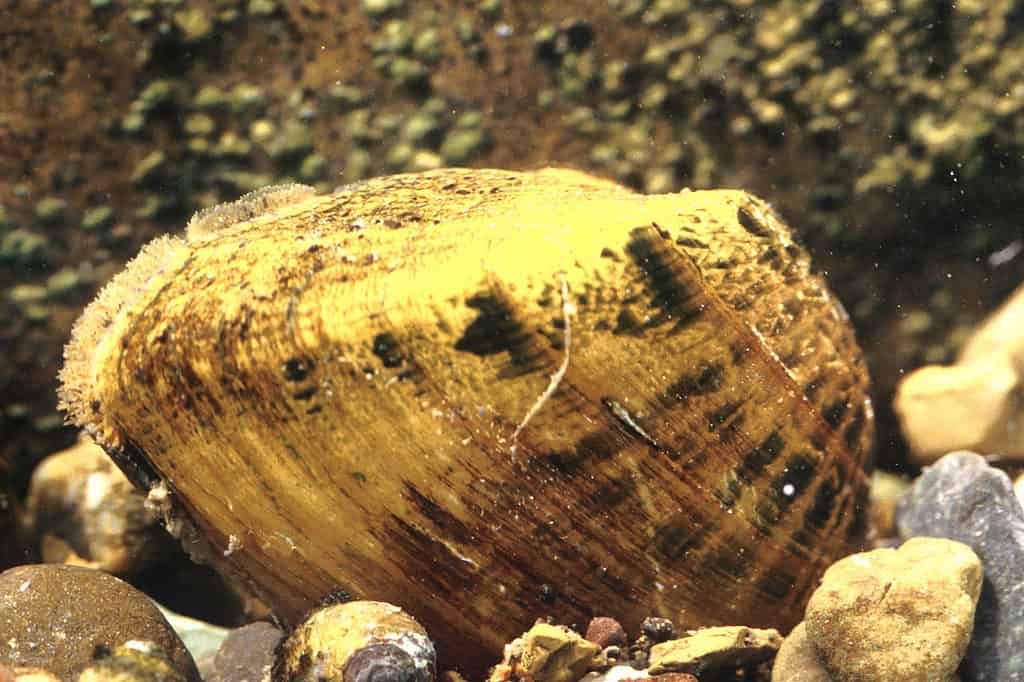
©Dick Biggins, U.S. Fish and Wildlife Service, Public domain, via Wikimedia Commons – License
Zoos in Missouri
People who don’t want to travel to wild spaces or who want to see more exotic beasts can visit Missouri’s many zoos.
Missouri is home to the world renowned St. Louis Zoo in Forest Park. Founded in 1910 and set on 90 acres, it has more than 16,000 animals, including monkeys, lemurs, grizzly bears, polar bears, penguins, puffins, seals, and sea lions. It is free to visit (apart from special attractions) and known for its commitment to animal research, conservation, and education.
Kansas City Zoo in Swope Park was established in 1909 and houses more than 1,700 animals on 202 acres. The zoo has animals primarily native to Africa, Australia, and Asia.
Wild Animal Safari in Strafford is the largest wild animal safari park in Missouri at 350 acres. It includes a zoo with 150 different species of animals and a 5-mile drive-through nature park that allows you to view more than 65 animal species — including elk, water buffalo, wildebeest, tigers, hyenas, and zebras — up close from your car, a rental or a safari bus, and even feed them with park purchased feed.
The World Bird Sanctuary in Valley Park is one of the largest facilities dedicated to the conservation of birds in North America and hundreds of injured birds yearly are treated at its onsite wildlife hospital. Other zoos include the Butterfly House in Clayton, the Dakota Zoo in Bismarck, and the Lazy L Safari Park in Cape Girardeau. Missouri’s St. Louis Zoo houses more than 16,000 animals, including the caiman lizard. ©TimVickers – Public Domain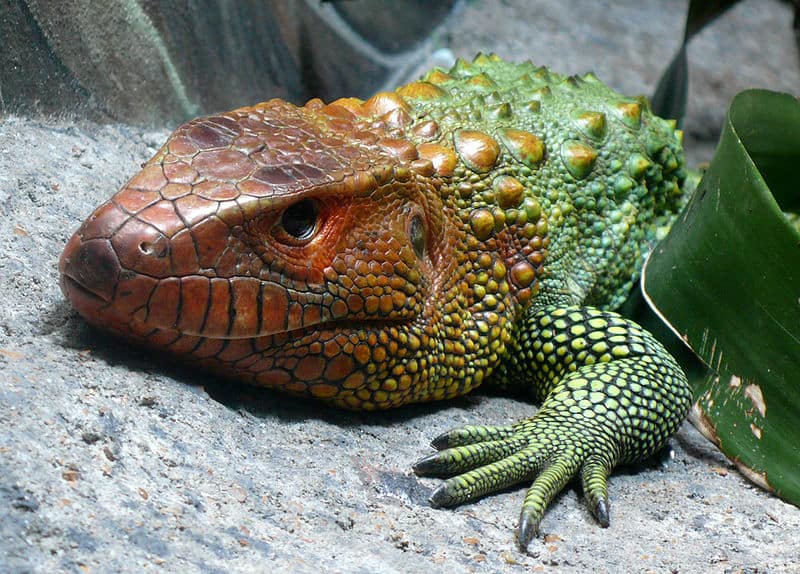
Largest Animals in Missouri
At the top of the list of the largest animals in Missouri is the bison, North America’s biggest land animal. A male can weigh 2,000 pounds or more and reach 6 feet tall, while a female typically can grow to 1,000 pounds and 5 feet tall. While American bison once were found throughout the state, they were driven out of Missouri by the 1840s and they have since been successfully reintroduced to Dunn Ranch Prairie in 2011.
Also large are North American black bears, the only bear native to Missouri, which can weigh in average between 220 and 590 pounds and reach a height of 4.25-6.5 feet and generally be found in the southern region of the state.
The state’s largest snake is the non-venomous bullsnake, which can get to be more than 8 feet long, and are commonly seen in the western region of Missouri.
One of the more unusual larger sized animals in the state is the alligator gar. This freshwater fish species with a long snout and torpedo-shaped body can grow to about 8 feet long and weigh up to 350 pounds. Alligator gars are found in almost all major rivers in Missouri.
Another large fish with a unique appearance, including a long snout shaped like a paddle, is the American paddlefish, which lives in the Mississippi River and its tributaries. While this species can grow on average to be 5 feet long and 60 pounds in weight, the biggest paddlefish caught in Missouri on record was 139 pounds 4 ounces. The unique American paddlefish can be found in the Mississippi River and its tributaries. ©Marina Veder/Shutterstock.com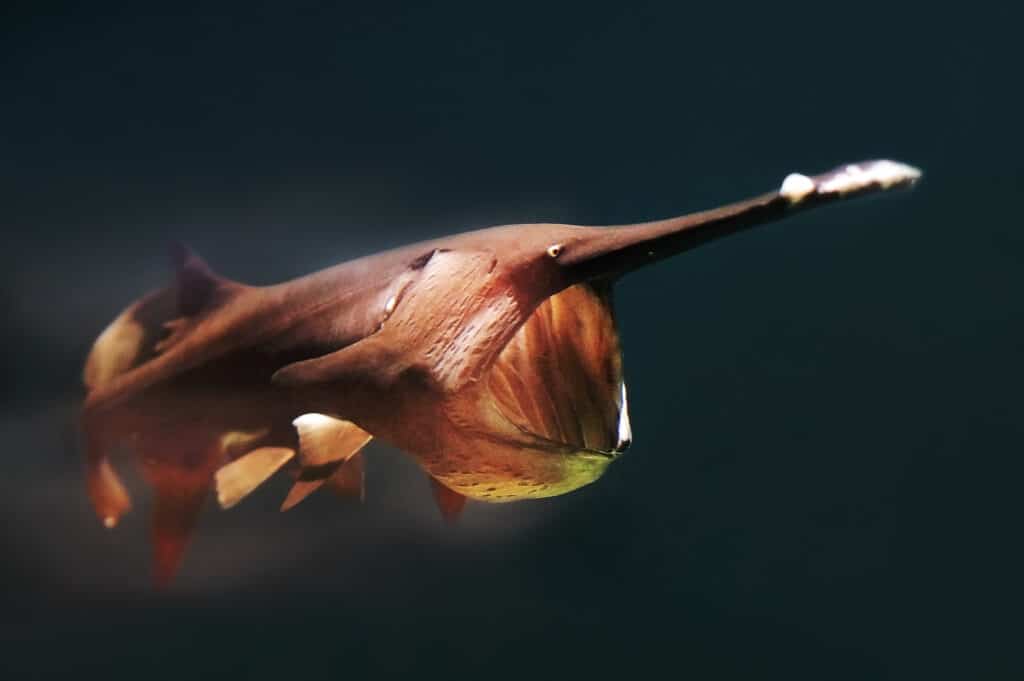
The Most Dangerous Animals in Missouri Today
Most truly dangerous animals have been extirpated from Missouri, but there are some to be respectful of. American black bears are present in the state after a population reintroduced to the Arkansas part of the Ozarks extended their range into Missouri. These bears should be watched at a safe distance, for some have come at humans. Mother bears are especially protective of cubs.
The black widow and the brown recluse are two venomous spiders native to Missouri. The black widow’s venom is neurotoxic, meaning that a bite can lead to muscle aches, chest pain, nausea, muscle tightness, cramping, and difficulty breathing. Around 90% of bites from brown recluses are not dangerous but 10% are and may even be fatal in some cases. These spiders typically avoid humans but if you do get bit, seek medical attention immediately.
The only tarantula in the state is the Missouri tarantula, also known as the Texas brown tarantula. While its bite hurts as much as a bee sting, the wounds can be painful and its venom can harm people who have an allergic reaction to it.
Other animals to watch out for are:
- Bison: These beasts can be short-tempered during the rut and can attack with little provocation.
- Snakes: There are five species of venomous snakes in Missouri to be aware of: the timber rattlesnake (rarely seen), massasauga rattlesnake (endangered), western pygmy rattlesnake (found in the southern part of the state), western cottonmouth (lives in the southeastern region) and the Osage copperhead (present statewide).
- White-tailed deer: The timid white-tail deer have been known to cause car wrecks when they try to run across highways or roads. Drivers should keep an eye out for them, especially during the fall rut.
- Alligator snapping turtle: A carnivorous turtle, the largest freshwater turtle of North America is not as aggressive as its name suggests. Some people keep the beast as a pet although it has a bite powerful enough to amputate fingers if it’s provoked.
- Ticks: These disease-carrying parasites are dangerous due to the diseases they carry.
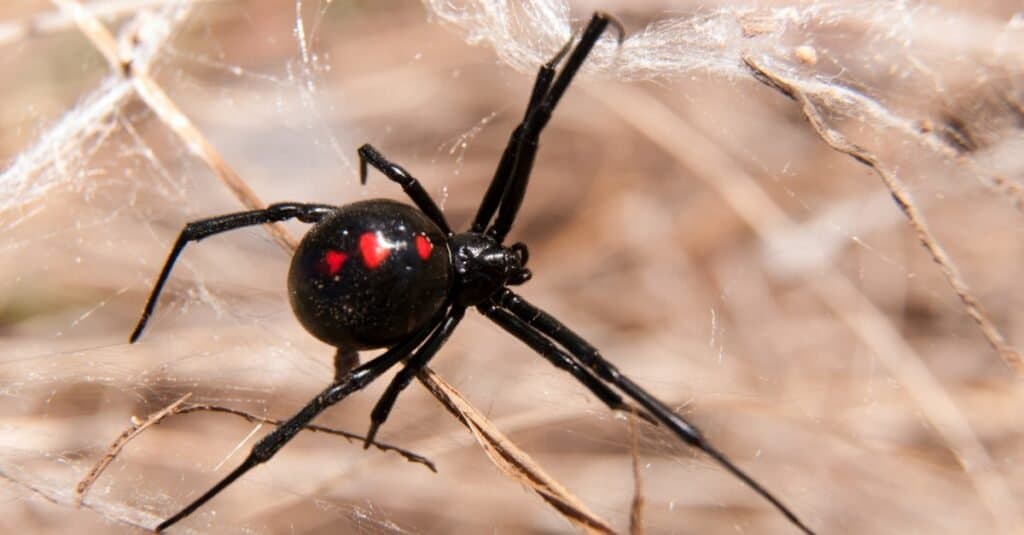
Black widow spider bites rarely kill people, but it’s important to get medical attention immediately once bitten.
©Sari ONeal/Shutterstock.com
Endangered Animals in Missouri
The Missouri Department of Conservation compiles a list of species it classes as endangered (these do not necessarily appear on U.S. Endangered Species List). It includes 20 fish, 7 reptiles and amphibians, 7 aquatic invertebrates, four mammals, three birds, and two land invertebrates.
Some of the animals on its endangered list are:
- Grotto sculpin: This fish is now only found in Perry County’s Bois Brule drainage and is endangered.
- Pink mucket: The pink mucket is one of the rarest of the freshwater mussels. It is endangered throughout the country and not just in Missouri.
- Ozark hellbender: This strange salamander with its flat head and frilled sides is classified as endangered.
- Indiana bat: These bats, which spend summer in north Missouri along streams and rivers, are endangered due to humans interrupting their winter hibernation and from white-nose syndrome, a fungal disease that causes bats to starve and die.
- Greater prairie chicken: Also known as the pinnated grouse, this bird breeds in grasslands in the spring and has become rare due to habitat loss.
Other animals that are endangered that can be found in Missouri are the eastern small-footed bat, sheepnose mussel, Blanding’s turtle, Ottoe skipper butterfly, and snuffbox, a freshwater mussel.

Greater prairie chickens, which breed in grasslands in the spring, have become rare due to habitat loss.
©Danita Delimont/Shutterstock.com
Rare Animals in Missouri:
Some of the rarest animals in the country are present in Missouri, including several rare species of fish.
The pallid sturgeon is one of the rarest of the sturgeons and is rarely seen in the wild. Found only in the lower Mississippi and Missouri river basins, it is in danger of extinction due to habitat destruction. The population in the Lower Missouri River has been affected by the water surface being reduced by half and the diversity of its habitat decreasing. Around 11,700 mature pallid sturgeons are surviving in Missouri.
Another sturgeon that is rare and endangered in the state is the lake sturgeon, Missouri’s largest sturgeon. Contrary to its name, this fish most often lives in big rivers, not lakes, in Missouri.
Other fish that are rare include the taillight shiner, which is one of the rarest Missouri minnows and can only be found in southeast Missouri, and the central mudminnow, which is the state’s sole mudminnow and is limited to a few marshy areas near the Mississippi River. Despite its name, the lake sturgeon typically lives in big rivers, not lakes, in Missouri. ©Geermy/Shutterstock.com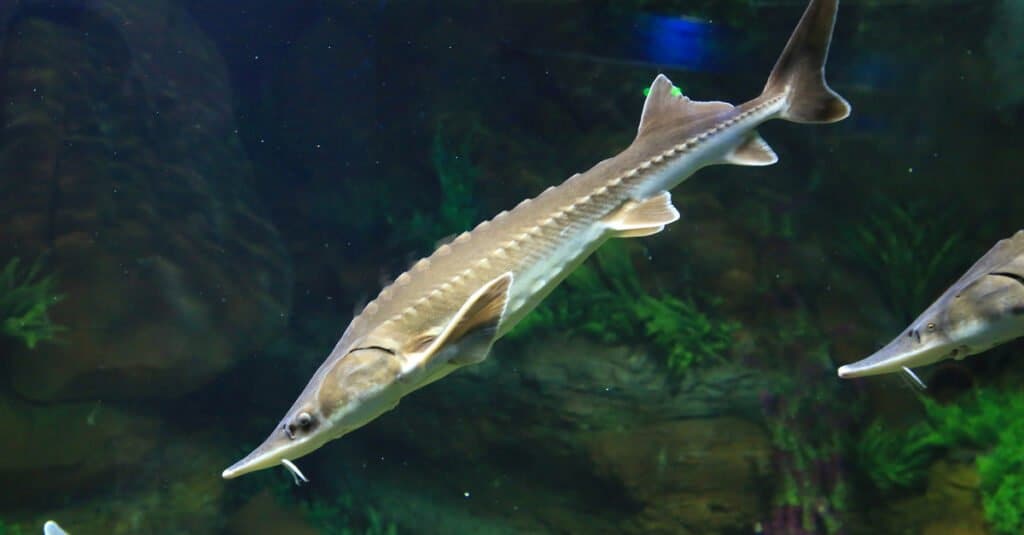
The Snowiest and Coldest Places in Missouri
The snowiest place in Missouri is a small city in Knox County called Edina which receives an average of 22 inches of snow per year compared to the rest of the state, which typically sees an average of 10 to 20 inches.
The coldest place in Missouri is Warsaw, a small city which recorded a temperature of -40 degrees Fahrenheit on February 13, 1905.
January is usually the coldest month in the state, with the average recorded maximum temperature being 43 degrees Fahrenheit and minimum temperature 26 degrees Fahrenheit. On average, Missouri receives 3.2 inches of snowfall during the first month of the year. It typically snows in January, February, March, November, and December. Warsaw is the coldest place in Missouri, having reached -40 degrees Fahrenheit in 1905.
©Tudoran Andrei/Shutterstock.com
Native Plants in Missouri
Missouri is home to highly diverse fauna, flora, and endemic species. The state spans all three floristic provinces that make up the North American Atlantic Region. Wildflowers, grasses, trees, shrubs, and other non-woody plants call Missouri home. Some native plants in Missouri include black-eyed Susan, cardinal flower, and blue vervain.
White hawthorn blossom was designated as the state flower in 1923. Missouri has more than 75 species of hawthorn growing across the state, with many located in the Ozarks. All have white blossoms similar to apple blossoms and in the fall sprout clusters of red fruit, which provides a food source for birds, small mammals and people, as it can be used to make jam.
The flowering dogwood was adopted as the state tree in 1955. This small tree, which reaches 40 feet in height and has clusters of tiny greenish-yellow flowers, is found in southern and central Missouri.
The Missouri Department of Conservation considers the following plants endangered: pondberry, red-berried elderberry, geocarpon, decurrent false aster, mead’s milkweed, Missouri bladderpod, running buffalo clover, Virginia sneezeweed, and western prairie fringed orchid. The state flower of Missouri, the white hawthorn blossom, provides food for birds. ©Rudmer Zwerver/Shutterstock.com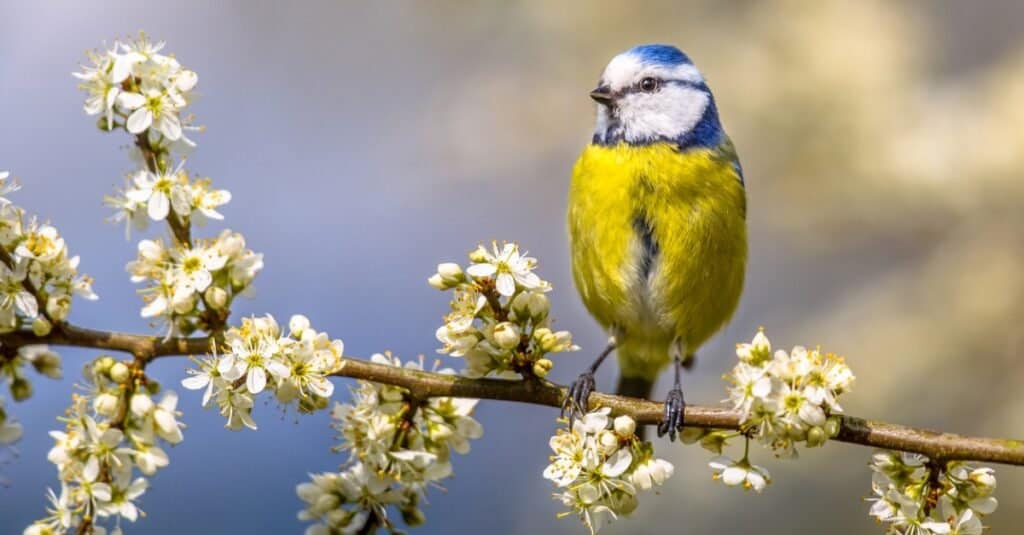
More Articles Related to Missouri
Read about:
- extinct animals that lived in Missouri.
- the best national parks and historic sites in Missouri.
- the types of hawks in Missouri.
- the most gorgeous waterfalls in Missouri.
- the best dog parks in St. Louis, Missouri.
- the longest biking trail in Missouri.
- the largest bear ever caught in Missouri.
- the best places to camp in Missouri.
- 7 fascinating animals that are endangered and living in Missouri
- Discover the Largest American Eel Ever Caught in Missouri
Missourian Animals

Admiral Butterfly
Stunningly beautiful wings
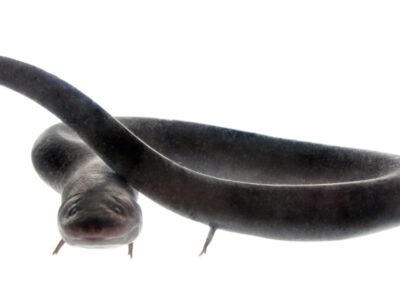
American Eel
Don't eat raw eel! Their blood is poisonous to humans when consumed raw.

Armyworm
They are so named because they "march" in armies of worms from one crop to another in search of food
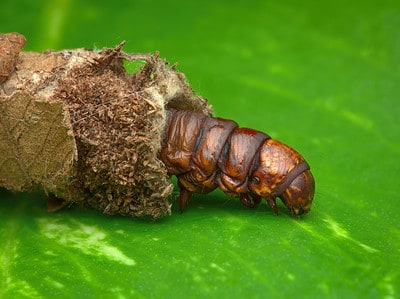
Bagworm Moth Caterpillar
They continually enlarge their protective cases

Beewolf wasp
They hunt bees
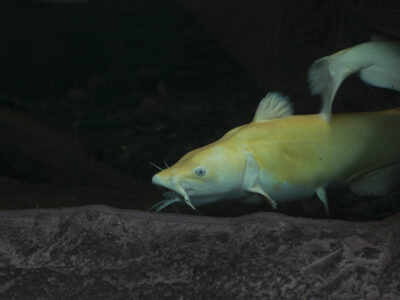
Blue Catfish
It's a strong fighter when caught on a fishing line
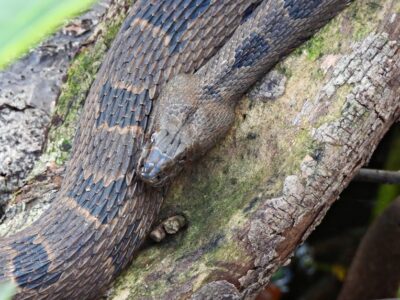
Brown Water Snake
Has more scales than any other water snake on the continent: 27 to 33 rows of dorsal scales!
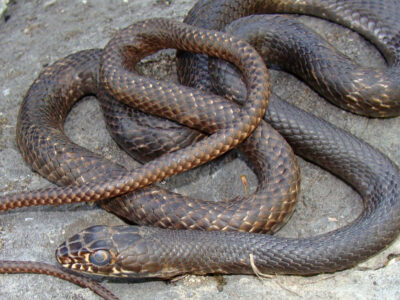
Coachwhip Snake
Coachwhip snakes pose little danger to people

Common Yellowthroat
The Common Yellowthroat stays close to the ground and uses stealth to survive!
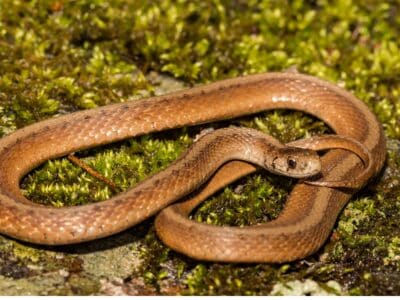
De Kay’s Brown Snake
They have specialized jaws for removing snails from shells.
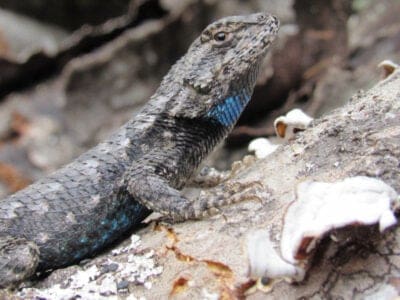
Eastern Fence Lizard
Females are usually larger than males.

Eastern Hognose Snake
Eastern hognose snakes are venomous, but only to frogs and toads.
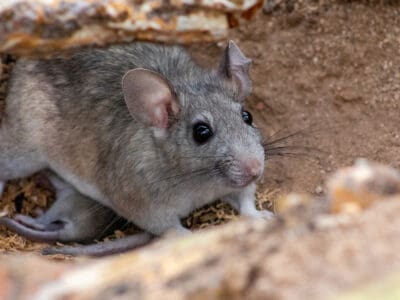
Eastern Woodrat
The eastern woodrat mating ritual involves a potentially deadly fight between the male and female before reproduction begins!

Flea
Adult fleas can jump up to 7 inches in the air
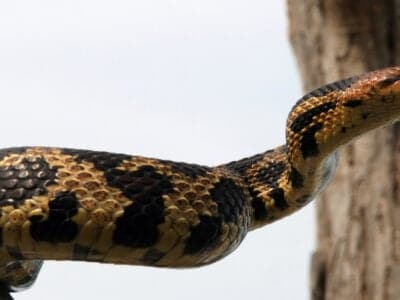
Fox Snakes
In some areas, fox snakes and gopher snakes have crossbred in the wild.
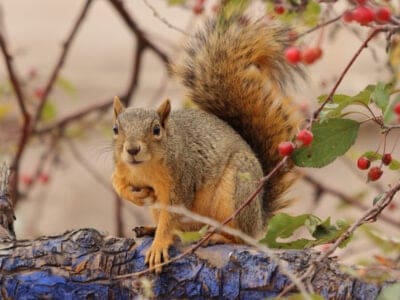
Fox Squirrel
Although it is a tree squirrel, it spends most of its time on the ground.
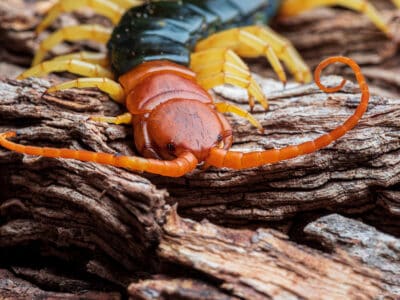
Giant Desert Centipede
They are the largest centipede in North America
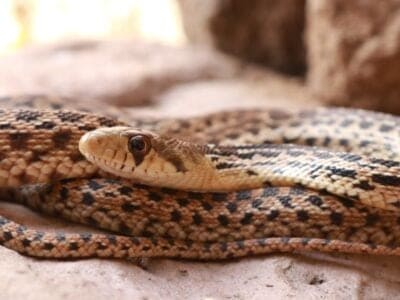
Gopher Snake
Gopher snakes can reach up to 9 feet long.
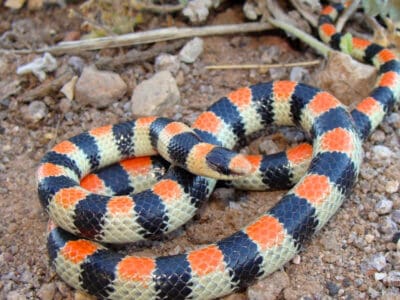
Ground Snake
It’s sometimes called a miter snake due to the marking on its head that looks like a bishop’s miter

Groundhog (Woodchuck)
They whistle to each other to warn of approaching danger!
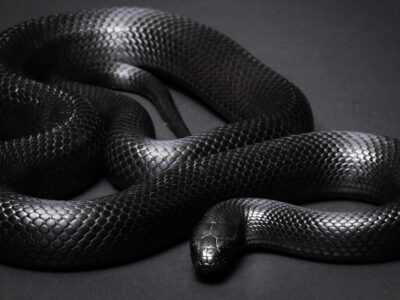
King Snake
King Snakes eat other types of snakes.

Massasauga
The name “Massasauga” comes from the Chippewa language, meaning “Great River Mouth”.

Mealybug
They have a symbiotic relationship with ants.

Mockingbird
Mockingbirds are incredible mimics that can learn hundreds of songs!
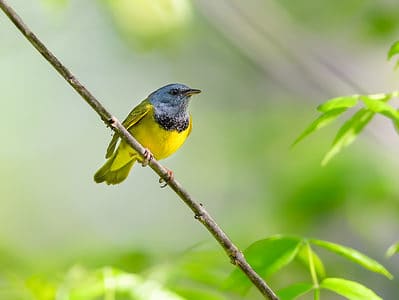
Mourning Warbler
The Mourning Warbler was named for its gray head, which resembles a mourning veil!

Nematode
Nematodes range in size from 1/10 of an inch to 28 feet long

Orb Weaver
Females are about four times the size of males

Owl
The owl can rotate its head some 270 degrees
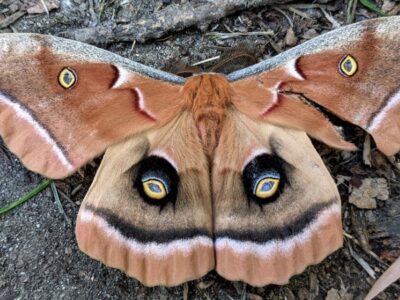
Polyphemus Moth
The Polyphemus moth doesn’t and can't eat, except when it's a caterpillar!

Pygmy Rattlesnake
Pygmy rattlesnakes’ rattle is so small it can only be heard from about three feet away.

Rat Snakes
Rat snakes are constrictors from the Colubridae family of snakes.
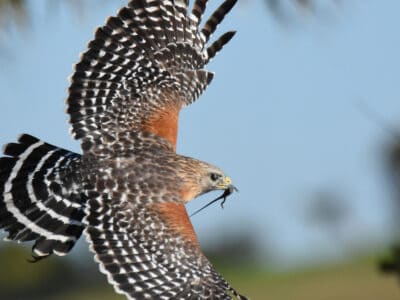
Red-Shouldered Hawk
Red-Shouldered Hawks reuse the same nesting area each year.

Rooster
Will mate with the entire flock!

Rough Earth Snake
It has a pointed snout that is uses to burrow into moist soil.

Smallmouth Bass
A fierce fighter!

Smokybrown Cockroach
Has up to 45 eggs per egg case
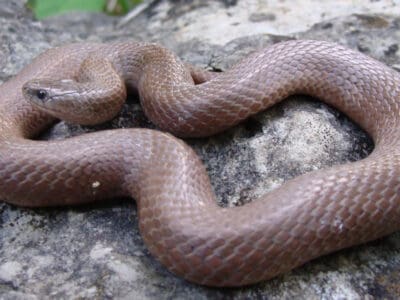
Smooth Earth Snake
Valeria Biddle Blaney (1828-1900) collected the first specimen in Maryland.

Tree Cricket
They make music with their wings

Western Rat Snake
Western rat snakes have special scales on their belly that help them climb up trees.
Missourian Animals List
- Admiral Butterfly
- Agkistrodon Contortrix
- American Eel
- Armyworm
- Bagworm Moth Caterpillar
- Beewolf wasp
- Blue Catfish
- Brown Water Snake
- Coachwhip Snake
- Common Yellowthroat
- Congo Snake
- De Kay’s Brown Snake
- Dire Wolf
- Eastern Fence Lizard
- Eastern Hognose Snake
- Eastern Woodrat
- Flea
- Fox Snakes
- Fox Squirrel
- Giant Desert Centipede
- Gopher Snake
- Ground Snake
- Groundhog (Woodchuck)
- King Snake
- Massasauga
- Mealybug
- Milk Snake
- Mockingbird
- Mourning Warbler
- Nematode
- Orb Weaver
- Owl
- Polyphemus Moth
- Pygmy Rattlesnake
- Rat Snakes
- Red-Shouldered Hawk
- Rooster
- Rough Earth Snake
- Smallmouth Bass
- Smokybrown Cockroach
- Smooth Earth Snake
- Southeastern Blueberry Bee
- Swallowtail Butterfly
- Tree Cricket
- Western Rat Snake
Animals in Missouri FAQs (Frequently Asked Questions)
Does Missouri have dangerous animals?
Missouri has a few dangerous animals, but none of them are exceptionally aggressive.
What animal is Missouri known for?
Missouri is most likely known for the Missouri mule, its state mammal.
What is Missouri's state mammal?
The state mammal is the Missouri mule.
What is the top predator in Missouri?
The top predator in Missouri is probably the bobcat. American black bears are mostly herbivores, but the bobcat is an obligate carnivore. This medium-sized cat has been known to take prey as large as deer.
What are some of the best lakes in Missouri?
Missouri is home to a number of lakes and reservoirs. Some of the best lakes in Missouri include Table Rock Lake, Lake of the Ozarks, Norfolk Lake, Lake Wappapello, and Smithville Lake.



